Burnout (GameCube) Review
By Adam Riley  25.06.2003
25.06.2003
After the Nintendo 64 finally went into early retirement, many fingered the lack of decent racing titles as one of its major downfalls. After all, Sony had Ridge Racer and Gran Turismo, whilst Sega's systems were home to Daytona and Sega Rally, whilst Nintendo had...well, nothing of interest to be honest. But all that was about to change with the launch of the GameCube, as Acclaim's critically-lauded arcade racer was to burn up consoles across the country from day one. Read on as C3 looks back at what was controversially classed as one of the best First Generation GC games...
Being a racing game, there is no storyline attached to Burnout. Many thanks go out to the good folk at Criterion Games for not attempting to concoct some pointless yarn just for the sake of it, because we all know how badly that can go at times (Will Mr Ridge Racer please stand up?). You simply have to hit the streets, build up as much boost as possible and leave the competition crying in your wake. Plain and simple, just the way all racers should be!
Considering it normally takes the actual console-maker a while to get-to-grips with the power contained within a new system, gamers are usually quite forgiving with Third Parties that produce titles with lacklustre graphics at the very beginning of a console's lifespan. But thanks to Criterion's superb Renderware software, the quality of Burnout on the GameCube actually far exceeds that of the original PlayStation 2 version that was released months prior. In fact, compared to the slew of sub-par Third Party efforts that hits the shelves from the 3rd May, 2002 onward, Burnout effortlessly stood out from the crowd.
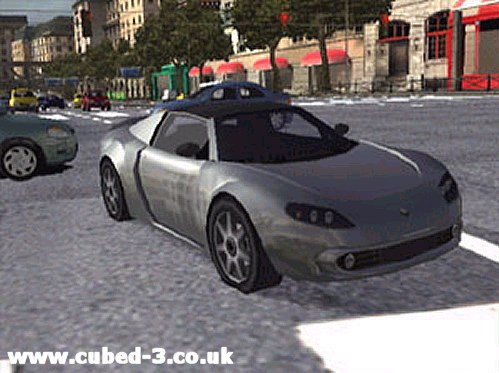
First of all there are the car models themselves, with their shiny exteriors that gleam amazingly in the realistic sun-lit locations, may not be as intricately detailed as those found in more well-known games, such as the seemingly-untouchable Gran Turismo, but they certainly do their job. There is certainly no glitching, whereby parts of the car flicker if too much action is going on at one time in this game! Then there is the fact that your vehicle and the three computer opponents are joined throughout the courses by hoards of traffic travelling in every direction (yes, there are dreaded crossroads on various tracks!), and yet the frame-rate still manages to linger around the 60 frames-per-second mark no matter what. Quite impressive for the company's first time out on the GameCube, I'm sure you will agree. Criterion really proves that its Renderware software is an extremely powerful tool if used correctly. The track layouts are especially of interest, being both expansive when it comes to the mountain themes and cluttered for the inner-city melees. All of this with no slowdown at all and minimal loading times show that despite the new computer architecture, Criterion are definitely quick on the up-take and ones to watch in the future.
Some will lament over how if a game lacks the right ‘feel’ in the sound department, then the whole experience can be killed within an instance, and in my opinion they would be completely correct. Just imagine zooming down the opposite side of the road, adrenaline pumping through your veins as you desperately try to avoid that huge lorry that’s coming your way…What sort of music are you associating with the experience? I’m guessing not plinky-plonky Japanese tunes, á la Mario Kart, and more along the lines of heavy beats, rocking tunes, or similar. You see, there is nothing better in a game such as this than having something loud and brash being pumped into your head as it helps to put you in ‘the zone’, a place that you will definitely need to be for this high-octane title.
But, unfortunately Burnout does not deliver what is required to the full extent. Most of the background tunes, whilst rocky in nature, do not always suit the particular track that you are racing on. Each track actually has its own individual theme music, but it really seems like someone created the pieces and another person just randomly allotted them to the available courses. Thankfully the sound effects are sufficiently ‘meaty’, especially when you inevitably crash. As your vehicle flies gracefully through the air, you can hear the wind whistling in the background before the final thuds, crashes, bangs and scrapes as you watch in amazement at the destruction taking place in front of your eyes. It sure makes up for the lacklustre music…
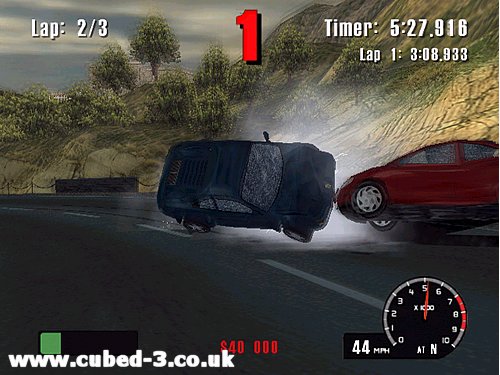
The premise of the majority of arcade racings games is ultimately simple: as soon as the light hits green, floor the accelerator and beat the rest of the competition in any way possible. Now Burnout is the same as past titles in that fashion, but it comes with a few modifications to help it stand out from the melee of racing games that can be found littered across every console nowadays. You see Criterion Games has introduced the element of a special boost meter, which you can only fill up by undertaking rather unorthodox forms of driving techniques. Every time you have a near miss with another vehicle, drive maniacally down the opposite side of the road or simply tap the break pedal to send your automobile skidding around bends at break-neck speeds, your meter will gradually fill. Once full, slamming your finger down on the boost button activates speeds that just do not seem possible. The surroundings will blur and the background music fades as a thumping heartbeat replaces it as you desperately try to keep control of your now-lightning-fast automobile, avoid accessing one of the many spectacular crash scenes that plague many a driver in the game and try (sometimes in vain) to reach that oh-so-close next checkpoint in order to make sure your on-screen timer does not run out, leaving you to retire early.
The different modes that are available from the start are Championship, where you race against three computer opponents across six unique tracks that morph into fourteen due to different routes and times of day, Single Player mode for practicing, Head-to-Head where two players challenge each other, Time Attack to improve your skills on-track without any competition and Special, which is where the unlocked modes appear later on. The Championship mode sees the player forced to meet or beat the final placing requirement whilst competing in three-race rallies. There is a slight annoyance, however, as the amount of crashes per race can seriously damage your chances of coming in pole position due to the length of the slow-motion replay that you are treated to with each collision and the fact that the timer between checkpoints also continues to count-down without pause. Once you do struggle through, Face Off mode unlocks whereby you battle to the finish-line against previously unseen vehicles, which are then themselves unlocked for selection when beaten. Eventually Free mode, leaving the various courses completely free of any vehicles, will become available and due to the extra processing-power available means that you will certainly notice an improvement in the computer AI that you face.
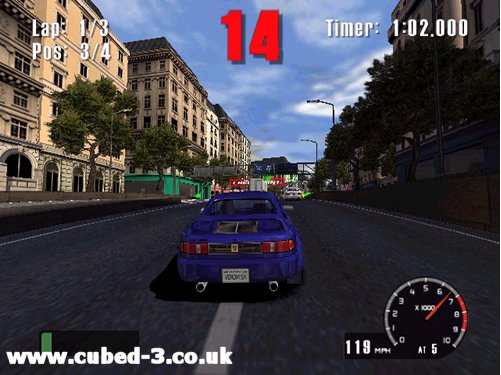
The developers managed to basically create a well-rounded game, in that anyone can easily jump straight in due to the easy pick-up-and-play nature, but also Burnout will appeal to long-term race fans who will cherish the challenge of trying to chain together as many Burnouts as possible whilst avoiding the lengthy crashes. Come on, let us give Criterion their well-deserved round of applause...
Unfortunately things will definitely come to an end sooner rather than later, which is a crying shame. It will not take a moderately skilled gamer an exceedingly long amount of time to breeze through the Championship mode, unlocking the few extra tracks and vehicles. That leaves the Time Trial option, which grows tiresome due to there only being a total of fourteen tracks in all. There is the two-player mode, though, which is immensely fun if both you and your opponent are of a high skill level, but things can equally fall into the realms of boredom relatively easily if playing with a weaker friend. Also, the Survival mode does not really add to the game's length as much as its creators would hope, as it is generally going to be over-looked by the majority of owners who do not see the point of proving they can get round the tracks without crashing even once. And finally, the limited amount of tracks, low number of vehicles and total lack of weather condition variety show that either the developers did not have enough time to incorporate these somewhat obvious features, or realised that they would be prime contenders for inclusion in a sequel. Thankfully, these qualms have indeed been rectified in Burnout 2: Point of Impact...
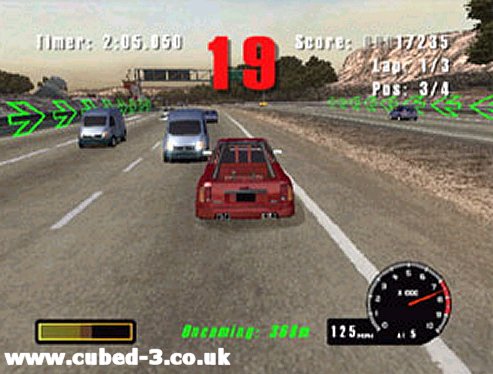
Cubed3 Rating
Very Good - Bronze Award

In the end, the core gameplay of Burnout is great, but there are far too many areas that leave the player feeling empty and unsatisfied. The final credits will roll far quicker than they should, and then you will simply be left wanting more, even though there is no more. Back at the GameCube's launch, though, this was by far the most impressive racer available. But now you would be well advised to steer clear and plump for Burnout 2: Point of Impact instead.
Comments
Comments are currently disabled

 Sign In
Sign In Game Details
Game Details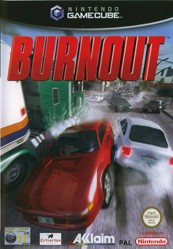
 Out now
Out now  Out now
Out now  Out now
Out now  Out now
Out now  Subscribe to this topic
Subscribe to this topic Features
Features





 Top
Top

